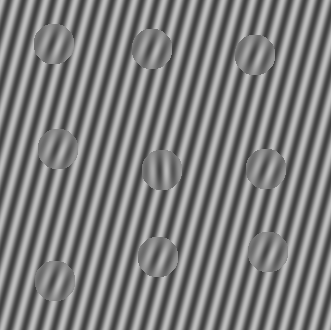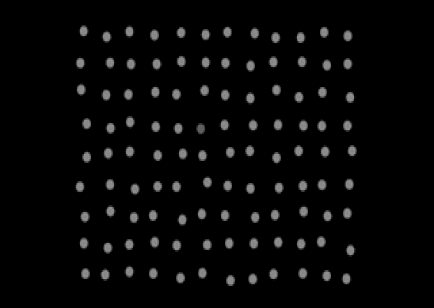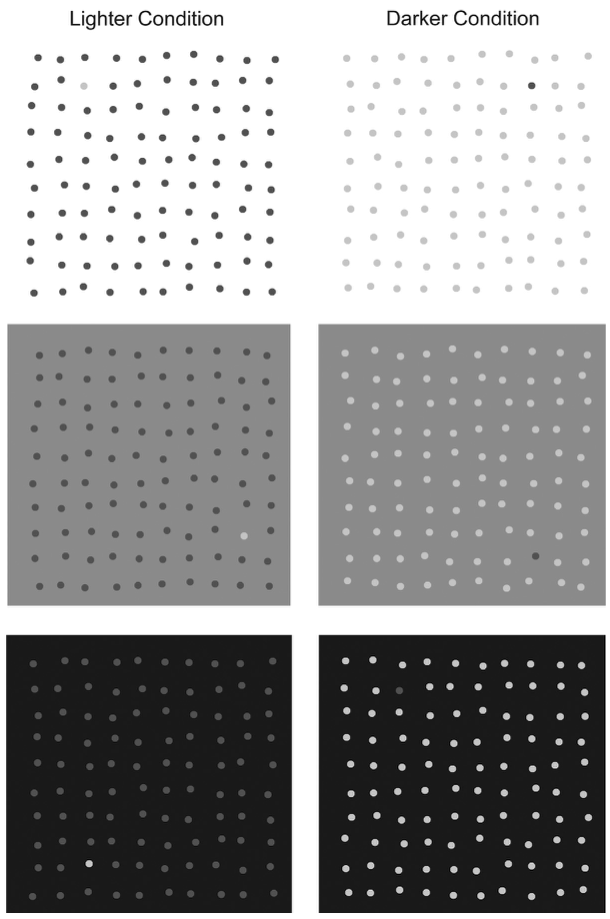|
When your doctor checks your mammogram for breast cancer you hope she or he does not miss anything important as it can be crucial to your future health. However, is that black and white x-ray in your doctor's hands the best aid to help her/him spot anything malignant? The study presented here does not directly address whether the visual properties of the x-ray are optimal for its purpose. However, it does address a broader more basic question of what lies underneath. How do properties of the background influence our ability to find the thing we're looking for? While not entirely ignored, the bulk of research on eye movements in visual search takes into account two components: What does the target (the object to look for) look like and what do the distractors (the other objects in the scene) look like? The background they are presented on receives relatively little attention. Considering the context in natural search is always defined by the complete surroundings and often what is background and what are objects may be hard to distinguish, we performed experiments that specifically focus on how changing the background affects search, while keeping other properties constant.
|
|
Each experiment had a similar setup: a target is placed in a field of distractors on a uniform background. Here I will focus on the luminance experiment, examples of which can be found to the right. In the lighter condition (left column) the target was lighter than the distractors and in the darker condition (right column) the target was darker than the distractors. I have included three different examples per condition with a white, mid-grey and black background. In the real experiment we used a wider range of backgrounds though. The reason we placed the target in a field of distractors is to obtain a considerable effect size so that we can easily distinguish more subtle effects as well: When a target has sufficient (visual) contrast with its surroundings it can be found rapidly as it will pop out. In contrast, when a target blends into a large field of distractors, finding it becomes a lengthy, iterative, process requiring several eye movements.
Returning to the luminance experiment the examples on the right we can distinguish a couple of cases to discus the results with. When the background is lighter than both target and distractor (as in the top row), whether the search is difficult depends on the the properties of the target and distractor. While in the lighter condition, the target blends in considerably with the distractors, in the darker condition it pops out immediately. When the background luminance falls between that of the target and distractor (and is not too close to that of the target) the target pops out again. Finally, when the background is darker than both target and distractor we find the opposite of when the background was lighter: Now search is faster when the target is lighter than the distractors rather than darker. However, a unifying principle underlying both results is most likely that the results can be explained by the relation between target, distractor and background. In the case of the light background search is fastest when the target is darker than both background and distractor. Vice versa, on a dark background search is fastest when the target is lighter than both background and distractor. Thus it appears a simple rule may be used to predict performance: When the value of the property distinguishing the target lies between that of the distractor and background search is slower, while a target value greater or smaller than both distractors and background results in a fast search. |

Finally, something that is not directly apparent from looking at the examples on this website, but quickly becomes apparent when performing the experiment in a darkened room, is that any anomaly on a black background is difficult to find. This can be explained by the fact that the complete removal of any alternate light source means that what is perceived as white is determined purely on the basis of the field of target and distractors. Now where the field of distractors in the lighter condition seems quite grey on this webpage, when viewed in the dark those distractors are used to determine what is white. Without considerable brighter light-sources the system will consider them to be very close to white. The target is still brighter, but considering that the distractors already appear close to white diminishes its pop-out effect.
The finding that a background in between the target and distractors leads to the fastest search results also generalises to manipulations in other domains. For instance, when we use orientation (rather than luminance) to distinguish target, distractors and background, search is fast when the background orientation lies between that of target and distractors. Most likely the same principle that causes the so-called tilt illusion is at play: If you look closely at the central element in the cutout to the right it looks tilted slightly to the left. In reality it is perfectly vertical, but the orientation of the right tilted background makes it appear tilted. If we now take into account that this background orientation, laying between that of the rotation of the target and distractors, not only causes the target to appear tilted left, but will cause the distractors to be perceived as tilting further right, you can imagine this creates a stronger difference between target and distractor and makes for a faster search.
In all it is clear that background is not a factor that should have been ignored to the extent that it has. While perhaps some oriented lines in an experimental setup will not be greatly influenced by a grey background, in real life background often introduces a complex texture that can strongly determine the difficulty of a search. Moreover, considering the fact that the luminance of a background strongly influences search, there are many design choices where the current results are relevant.
The finding that a background in between the target and distractors leads to the fastest search results also generalises to manipulations in other domains. For instance, when we use orientation (rather than luminance) to distinguish target, distractors and background, search is fast when the background orientation lies between that of target and distractors. Most likely the same principle that causes the so-called tilt illusion is at play: If you look closely at the central element in the cutout to the right it looks tilted slightly to the left. In reality it is perfectly vertical, but the orientation of the right tilted background makes it appear tilted. If we now take into account that this background orientation, laying between that of the rotation of the target and distractors, not only causes the target to appear tilted left, but will cause the distractors to be perceived as tilting further right, you can imagine this creates a stronger difference between target and distractor and makes for a faster search.
In all it is clear that background is not a factor that should have been ignored to the extent that it has. While perhaps some oriented lines in an experimental setup will not be greatly influenced by a grey background, in real life background often introduces a complex texture that can strongly determine the difficulty of a search. Moreover, considering the fact that the luminance of a background strongly influences search, there are many design choices where the current results are relevant.
|
de Vries, J.P., Hooge, I.T.C., Wertheim, A.H., & Verstraten, F.A.J. (2013). Background, an important factor in visual search. Vision Research, 86, 128–38.
|


